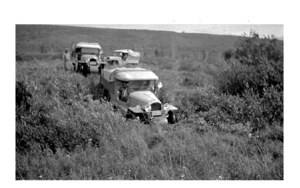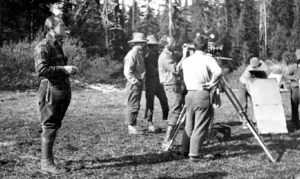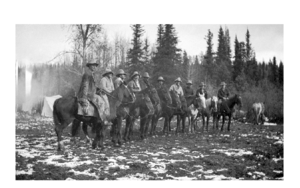Bedaux expedition facts for kids
The Bedaux expedition of 1934 was an exciting adventure led by a wealthy French explorer named Charles Bedaux. He wanted to cross the wild northern parts of Alberta and British Columbia in Canada. His goals were to film the journey, test special Citroën half-track vehicles, and gain fame for himself.
Bedaux started this amazing trip with over a hundred people. This included his wife, an Academy Award-winning film director from Hollywood, Floyd Crosby, and many Alberta cowboys. The Canadian government also sent two geographers, Frank Swannell and Ernest Lemarque, to map the route. The expedition began in Edmonton, Alberta on July 6, 1934. Their big goal was to travel about 2,400 kilometers (1,500 miles) to Telegraph Creek, British Columbia. Much of this journey would be through areas with no roads or trails.
Contents
The Bedaux Expedition: An Adventure in Canada
Planning the Big Trip
The journey through Alberta started in Edmonton. From there, the group planned to go to Athabasca, then Grande Prairie. After that, they would enter British Columbia, passing through Dawson Creek and Fort St. John.
From Fort St. John, the expedition aimed to head north to Montney. Then they would go northwest to Halfway River and on to Whitewater Post. This part of the trip involved crossing the Northern Rocky Mountains. Bedaux hoped to cross the Sifton Pass, reach Dease Lake, and follow the Stikine River to Telegraph Creek. Their final destination was the Pacific Ocean. However, they never completed this last part of the journey.
Training Camp in Jasper
In June 1934, Bedaux gathered everyone for the expedition in Jasper, Alberta. He said they needed fitness training for the long and hard trip. This training would include hiking, rafting, and mountain climbing.
However, no real training happened. Instead, the expedition members were busy attending many parties and fancy dinners held in their honor. They enjoyed lots of champagne and formal meals.
Special Vehicles for Tough Terrain

Bedaux knew André Citroën, who made the special Citroën-Kégresse half-track trucks. These unique vehicles were used for the expedition. There were five Citroën half-tracks in total.
During the trip, two of these trucks accidentally slid off cliffs. A third truck was used for a film scene where it was supposed to explode on a raft. But the explosion didn't happen, and the truck floated away, getting stuck in a sandbar. The last two Citroëns were left behind near Halfway River. Years later, when the Alaska Highway was built in the 1940s, a man found the remains of these two half-tracks. One of them was given to the Western Development Museum in Moose Jaw, Saskatchewan.
The Journey Begins
The expedition officially started after a fancy champagne breakfast in Edmonton. They paraded down Jasper Avenue and were sent off by Alberta's Lieutenant Governor. Soon after leaving the city, it began to rain. This bad weather stayed with them for much of the trip.
Despite the rain and poor roads, they made good progress. By July 12, they left Grande Prairie. On July 17, they were in British Columbia, on the trail from Taylor to Fort St. John. The group stayed in Fort St. John until July 22. They bought supplies, fixed the Citroëns, hired more cowboys, and attended more banquets.
Challenges on the Trail
Bedaux decided the expedition needed to be even more famous. He fired his radio operator and announced they would continue without a radio. He also decided that the Citroëns should be destroyed on film to create a bigger sensation.
In August, two Citroëns were pushed off a 90-meter (300-foot) cliff near Halfway River. A third was floated downriver for the explosion scene that didn't work out. Still, Bedaux's plan worked. Newspapers in Canada and America reported that three cars were lost and some members barely escaped. The party was praised for their bravery and determination to keep going despite these "accidents."
By mid-September, newspapers reported that the expedition would reach its goal in October. But when they arrived at Whitewater Pass, Frank Swannell, an expert on Northern British Columbia, advised Bedaux not to go further. The mountain passes were covered in snow. His advice was proven right when the horses started getting sick and dying. The route was simply too hard to continue. On October 17, the Edmonton Journal reported that the party was turning back.
The group reached Hudson's Hope after almost four months in the wilderness. A huge party was held to celebrate their amazing effort. It was one of the biggest celebrations the town had ever seen.
What Happened to the Movie?
The film footage shot by Floyd Crosby disappeared for many years. It was finally found decades later in a basement in Paris. In 1995, a documentary called The Champagne Safari was made by filmmaker George Ungar, using this old footage.
Remembering the Expedition
Some places in Canada are named after Charles Bedaux and his expedition:
- The Bedaux Pass, located at the start of the Muskwa River, in the Kwadacha Wilderness Provincial Park.
- Mount Bedaux.




